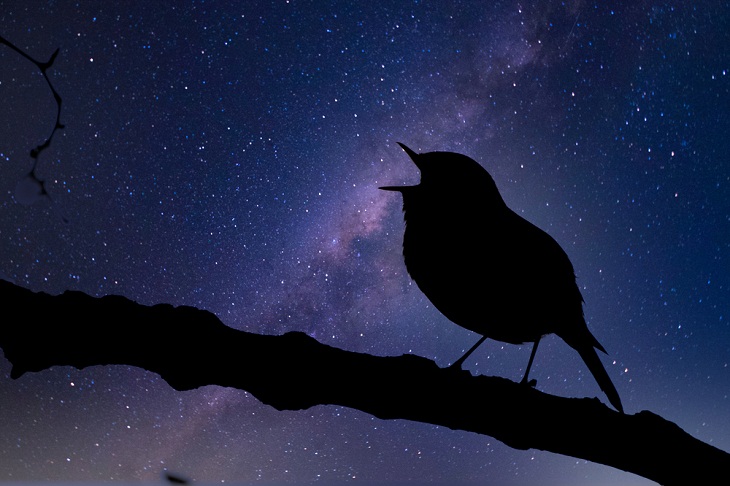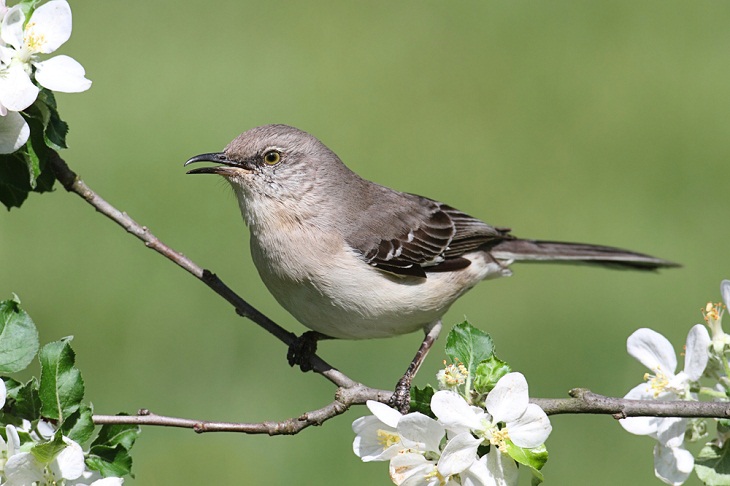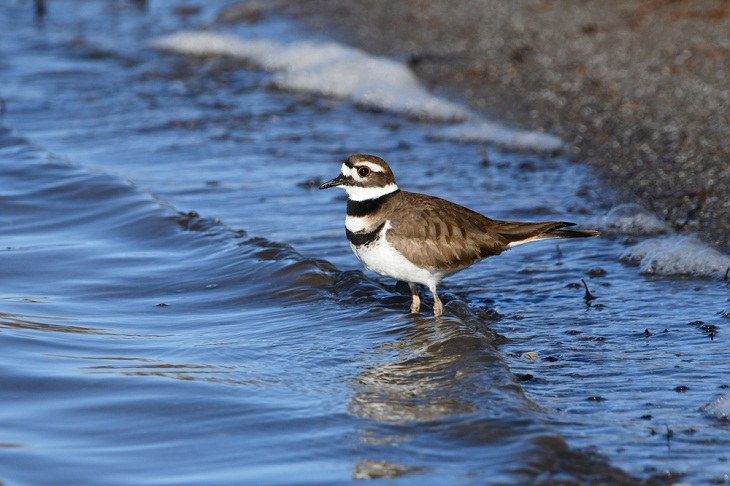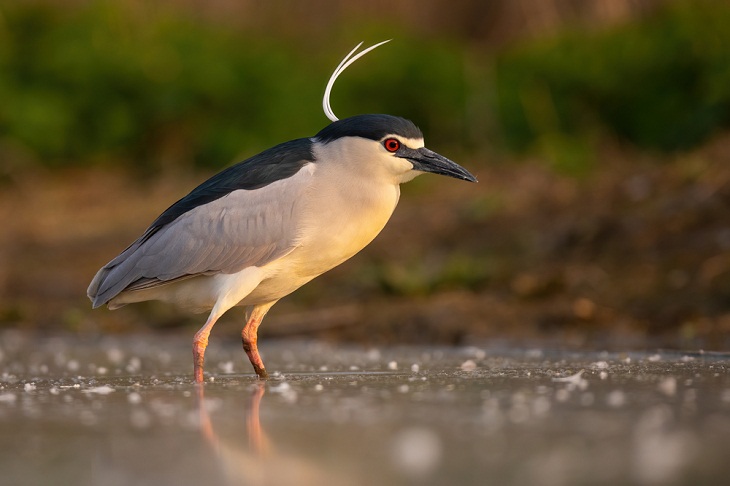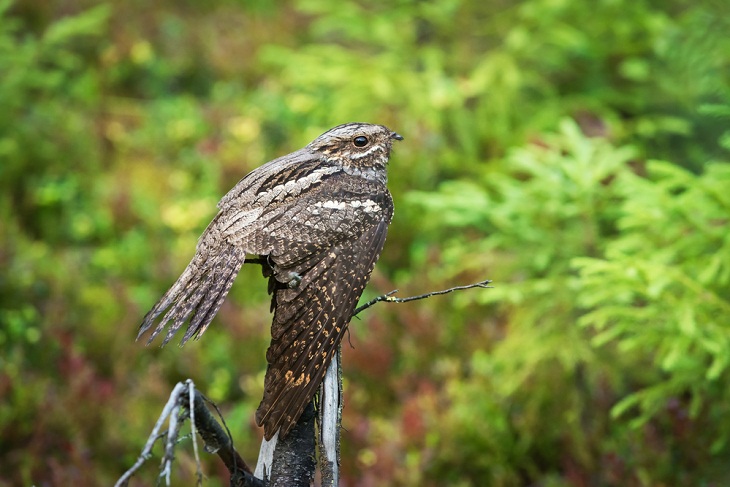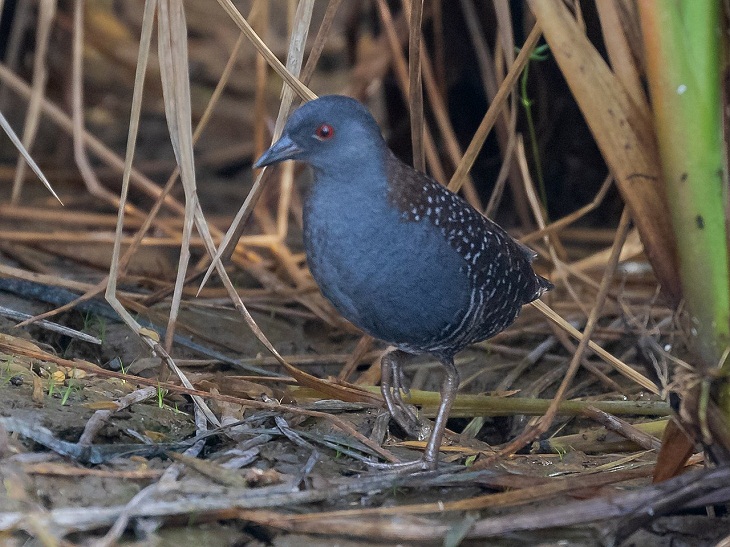All avian species, whether active during the day or night, follow the natural rhythm of light and darkness. The onset of the morning song, known as the dawn chorus, is influenced by both the bird's internal clock and the first rays of sunlight.
Because certain birds can sing even at low light levels and continue to perform until twilight, their singing period may extend into the night.
Robins, insect-eating birds well adapted to dim lighting conditions, are known to forage and feed under artificial light late into the night. They are among the first birds to initiate the dawn chorus and are also among the last to cease their nighttime singing.
Apart from light, there are other stimuli that can trigger nocturnal singing in robins and certain other bird species. Sudden noises like thunder, fireworks, earthquakes, wartime bombings, or even the shaking of their roosting tree can abruptly awaken a bird and prompt it to burst into song. Robins can even be influenced to join in the singing of other nighttime birds, such as the distantly related nightingale.
Experts have observed a correlation between daytime noise pollution and the shift of diurnal birds to nocturnal singing, as it offers them a more peaceful soundscape. Furthermore, in regions where nocturnal birds abound, diurnal species might awaken during the night and actively respond to the melodic calls of their nocturnal counterparts.
9 Beautiful Birds Who Sing At Night
1. Northern Mockingbird
The northern mockingbird (Mimus polyglottos) is a skilled imitator with a diverse repertoire that can be found across the United States, southern Canada, Mexico, and the Caribbean. Once darkness falls, these feathered beings fill the air with melodies reminiscent of a complete choir in full force. They showcase their vocal abilities by singing various tones, notes, and sequences in sets of three, frequently transitioning to new tunes. They often perch high and are commonly seen in urban and suburban areas.
This medium-sized songbird primarily mimics other bird species such as jays, orioles, and hawks, but it can also imitate the croaks of frogs, the sound of creaky doors, and car alarms.
Mockingbirds have the ability to learn up to 200 songs throughout their lives. Both males and females sing, but males are usually more noticeable and organize their songs into seasonal playlists for fall or spring. Although they are not strictly nocturnal, unpaired males may sing continuously for 24 hours a day during the breeding season, particularly when there is a full moon, which occurs in spring to early summer.
2. Hermit Thrush
This exquisite songbird, adorned in reddish-brown plumage, is among the most charismatic vocalists found in North America. Its habitat spans from Mexico to Canada, varying with the season and migration patterns.
Emitting a melodious tune characterized by enchanting whistles and trills, this avian marvel is readily audible, often serenading during the late evening and early morning hours. This tendency becomes more pronounced during the onset of spring and the conclusion of autumn, when its nocturnal symphony may extend deep into the night.
3. European Robin
European robins (Erithacus rubecula) are known for establishing and defending territories where they sing throughout the year. While they are not naturally nocturnal, they have adapted well to twilight conditions. Consequently, they often become the first birds to sing at dawn and the last ones to stop singing after dusk.
According to the Royal Society for the Protection of Birds, the robin is the most commonly heard nighttime songbird in British towns and gardens. This has led to insomniac robins being misidentified as nightingales. Similar instances of night-singing have been observed in other non-nocturnal species like blackbirds, but European robins appear to exhibit this behavior more frequently.
Robins rely heavily on light levels to determine their singing patterns, making them susceptible to confusion caused by artificial electric lights. The constant singing can lead to overexertion. While reducing light pollution might assist in mitigating this issue, research has indicated that daytime city noise can also prompt robins to sing at night.
4. Great Reed Warbler
The Royal Society for the Protection of Birds says that various species in the Acrocephalus genus, including reed and sedge warblers, are known to engage in extensive nocturnal singing during the breeding season. These small songbirds, which feed on insects, inhabit a wide range from Western Europe and Africa to Asia and Oceania, with some even found in distant locations like Hawaii and Kiribati.
Among these species, the great reed warbler (Acrocephalus arundinaceus) is particularly widespread. It breeds across mainland Europe and Asia in the spring and summer and migrates to sub-Saharan Africa for the winter. Male great reed warblers attract females with a powerful song that can last from 20 seconds to 20 minutes without a pause. Their melodious calls can be heard from distances of up to approximately 1,500 feet (457 ft).
5. Killdeer
The beautiful coastal bird conveys an incredibly distinctive and piercing vocalization that sounds like a frantic, chattering melody. Regardless of the time of day, these birds frequently emit their calls while flying. During the late autumn and early spring migrations, they may continue calling throughout the night.
To catch the sound of killdeers, bird enthusiasts should actively listen for these recognizable birds in their preferred habitats near shallow water or open, desolate fields that provide suitable conditions for nesting and searching for food.
6. Black-Crowned Night Heron
The black-crowned night heron (Nycticorax nycticorax) is a well-known heron species that can be found in North America (including most of the U.S.), South America, Africa, and Eurasia. This opportunistic feeder is adaptable to various wetland environments and tends to nest in colonies while often foraging independently.
Although not considered melodic songs, the heron's distinctive croaks and barks create an eerie atmosphere in its habitats at night. These vocalizations contribute to a creepy ambiance in the marshes, swamps, and wetlands these birds inhabit across their distribution.
7. Yellow-Breasted Chat
Known for its vibrant yellow breast and bold personality, the yellow-breasted chat (Icteria virens) is a remarkable nocturnal singer. Its melodic and complex song resembles a medley of various other bird calls, earning it the nickname "mockingbird of the Americas."
During a brief period each spring in North America, the yellow-breasted chat graces the darkness with its songs. With its repertoire of whistles, trills, and gurgles, this gorgeous bird fills the night air with its enchanting and unpredictable serenades, making it a cherished member of the avian chorus. While chats thrive primarily during the day, they often migrate at night. Thus, when most other birds embrace silence, the chat claims the auditory spotlight for itself.
8. Eurasian Nightjar
The Eurasian nightjar (Caprimulgus europaeus) is a stunning nocturnal bird renowned for its unique vocalizations and mesmerizing aerial displays. This medium-sized bird, often mistaken for a large moth in flight, thrives in a diverse range of habitats, including woodlands, heaths, and open landscapes across Europe and Asia.
With a distinct churring sound, the male nightjar fills the night air with its haunting calls, which resemble the rhythmic revving of a distant engine. These vocalizations serve as territorial displays and courtship rituals, attracting females and asserting dominance over competing males. Accompanied by graceful and agile flight patterns, the nightjar's display includes wing clapping and swooping flights, adding to its allure.
Adapted to low-light conditions, the Eurasian nightjar possesses cryptic plumage that blends seamlessly with its surroundings, making it an expert in camouflage. Its large eyes, equipped with high numbers of light-sensitive cells, aid in hunting insects during twilight hours.
9. Black Rail
Rails inhabit diverse environments across all continents, except Antarctica. Measuring a mere 5 inches in length, the Black Rail (Laterallus jamaicensis) lurks within dense marshes and wetlands, shrouded in secrecy.
Under the cover of darkness, this elusive avian maestro unleashes its extraordinary vocal prowess, enthralling listeners with a symphony of distinctive ki-ki-doo calls. Its song, a harmonious blend of clicks, grunts, and whistles, resonates through the stillness of the night, adding an ethereal touch to the nocturnal soundscape.

